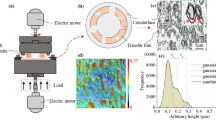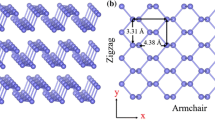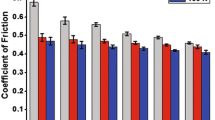Abstract
The most important application of polytetrafluoroethylene (PTFE) polymer in industry is its use as a solid lubricant, due to its lack of reactivity with most industrial materials. However, the PTFE polymer has low abrasive resistance that limited its usage. In this research, 0, 2, and 5% of nanoclay were added to PTFE polymer as filler, and properties of the resultant nanocomposites were investigated. For this purpose, the nanoclay was first dissolved in a solution of water and surfactant, and then added into the PTFE. After thoroughly mixing, the cylindrical specimens were produced by cold pressing and heated to 340 °C for 2 h in an atmosphere-protected furnace. EDS analysis, electron scanning microscopy and pin-on-disk wear test were done on nanocomposites. The results of the EDS proved the uniform distribution of nanoclay in the matrix of PTFE. The abrasion test showed that the wear resistance was more than 100 times in the nanocomposite containing 5% nanoclay than PTFE. The investigation of the abrasive particles showed that the particles separated from polymer are longer and thicker than those separated from nanocomposite. By observing the surface of the abrasive pin after the wear test, it became clear that the transfer film from the PTFE polymer was formed on the surface of the abrasive pin and prevented the nanocomposite from the abrasion directly. Therefore, the abrasion mechanism in nanocomposites is “abrasive” due to the surface adhesion.











Similar content being viewed by others
References
Bhargava S, Koratkar N, Blanchet TA (2015) Effect of platelet thickness on wear of graphene–polytetrafluoroethylene (PTFE) composites. Tribol Lett 59:17
Ahad IU, Butruk B, Ayele M, Budner B, Bartnik A, Fiedorowicz H, Ciach T, Brabazon D (2015) Extreme ultraviolet (EUV) surface modification of polytetrafluoroethylene (PTFE) for control of biocompatibility. Nucl Instrum Methods Phys Res Sect B 364:98–107
Mack F, Morawietz T, Hiesgen R, Kramer D, Gogel V, Zeis R (2016) Influence of the polytetrafluoroethylene content on the performance of high-temperature polymer electrolyte membrane fuel cell electrodes. Int J Hydrogen Energy 41:7475–7483
Hunke H, Soin N, Shah TH, Kramer E, Pascual A, Karuna MSL, Siores E (2015) Low-pressure H2, NH3 microwave plasma treatment of polytetrafluoroethylene (PTFE) powders: chemical, thermal and wettability analysis. Materials 8:2258–2275
Somé SC, Delaunay D, Faraj J, Bailleul JL, Boyard N, Quilliet S (2015) Modeling of the thermal contact resistance time evolution at polymer–mold interface during injection molding: effect of polymers’ solidification. Appl Therm Eng 84:150–157
Huang A, Peng X, Turng LS (2018) In-situ fibrillated polytetrafluoroethylene (PTFE) in thermoplastic polyurethane (TPU) via melt blending: effect on rheological behavior, mechanical properties, and microcellular foamability. Polymer 134:263–274
Huang A, Wang H, Peng X, Turng LS (2018) Polylactide/thermoplastic polyurethane/polytetrafluoroethylene nanocomposites with in situ fibrillated polytetrafluoroethylene and nanomechanical properties at the interface using atomic force microscopy. Polym Test 67:22–30
Xue X, Fu Y, Wang Q, Xing L, Zhang Y (2016) Outputting olfactory bionic electric impulse by PANI/PTFE/PANI sandwich nanostructures and their application as flexible, smelling electronic skin. Adv Funct Mater 26:3128–3138
Yu Y, Li Z, Wang Y, Gong S, Wang X (2015) Sequential infiltration synthesis of doped polymer films with tunable electrical properties for efficient triboelectric nanogenerator development. Adv Mater 27:4938–4944
Kececi E, Asmatulu R (2017) Effects of moisture ingressions on mechanical properties of honeycomb-structured fiber composites for aerospace applications. Int J Adv Manuf Technol 88:459–470
Clark AD, Sarkar S (2015) Aerospace hose having epdm rubber layer. US Patents 20150330538A1
Cheng ZL, Chang XY, Liu Z, Qin DZ, Zhu AP (2017) High-performance PTFE nanocomposites based on halloysite nanotubes. Clay Miner 52:427–438
Song F, Wang Q, Wang T (2016) The effects of crystallinity on the mechanical properties and the limiting PV (pressure × velocity) value of PTFE. Tribol Int 93:1–10
Qing W, Shi X, Deng Y, Zhang W, Wang J, Tang CY (2017) Robust superhydrophobic-superoleophilic polytetrafluoroethylene nanofibrous membrane for oil/water separation. J Membr Sci 540:354–361
Bagale D, Shekhawat S, Chaudhari J (2013) Wear analysis of polytetrafluoroethylene and it’s composites under dry conditions using Design-Expert. Int J Sci Res Pub 3:170–175
Fragassa C (2016) Investigations into the degradation of PTFE surface properties by accelerated aging tests. Tribol Ind 38:241–248
Hunke H, Soin N, Shah T, Kramer E, Witan K, Siores E (2015) Influence of plasma pre-treatment of polytetrafluoroethylene (PTFE) micropowders on the mechanical and tribological performance of polyethersulfone (PESU)–PTFE composites. Wear 328:480–487
Sawyer WG, Freudenberg KD, Bhimaraj P, Schadler LS (2003) A study on the friction and wear behavior of PTFE filled with alumina nanoparticles. Wear 254:573–580
Harris KL, Pitenis AA, Sawyer WG, Krick BA, Blackman GS, Kasprzak DJ, Junk CP (2015) PTFE tribology and the role of mechanochemistry in the development of protective surface films. Macromolcules 48:3739–3745
Luo W, Liu Q, Li Y, Zhou S, Zou H, Liang M (2016) Enhanced mechanical and tribological properties in polyphenylene sulfide/polytetrafluoroethylene composites reinforced by short carbon fiber. Compos Part B Eng 91:579–588
Song F, Wang Q, Wang T (2016) Effects of glass fiber and molybdenum disulfide on tribological behaviors and PV limit of chopped carbon fiber reinforced Polytetrafluoroethylene composites. Tribol Int 104:392–401
van Rooyen LJ, Bissett H, Khoathane M, Karger-Kocsis J (2016) Gas barrier properties of oxyfluorinated graphene filled polytetrafluoroethylene nanocomposites. Carbon 109:30–39
Amrishraj D, Senthilvelan T (2019) Development of wear mechanism maps for acrylonitrile butadiene styrene hybrid composites reinforced with nano zirconia and PTFE under dry sliding condition. J Tribol 141:021602
Suresh G, Vasu V, Rao MV (2018) A composite (taguchi-utility-rsm) approach for optimizing the tribological responses of polytetrafluoroethylene (PTFE) nanocomposites for self-lubrication applications. Silicon 10:1–11
Cai X, Jiang Z, Zhang X, Gao T, Yue K, Zhang X (2018) Thermal property improvement of polytetrafluoroethylene nanocomposites with graphene nanoplatelets. RSC Adv 8:11367–11374
Li F, Hu K, Li J, Zhao B (2001) The friction and wear characteristics of nanometer ZnO filled polytetrafluoroethylene. Wear 249:877–882
Nguyen-Tri P, Nguyen TA, Carriere P, Ngo Xuan C (2018) Nanocomposite coatings: preparation, characterization, properties, and applications. Int J Corros 2018:4749501
Golgoon A, Aliofkhazraei M, Toorani M, Moradi M, Rouhaghdam AS (2015) Corrosion and wear properties of nanoclay–polyester nanocomposite coatings fabricated by electrostatic method. Procedia Mater Sci 11:536–541
Rafiee R, Shahzadi R (2018) Predicting mechanical properties of nanoclay/polymer composites using stochastic approach. Compos Part B Eng 152:31–42
Chaen S, Kiyotani H, Inui K, Yamanaka T, Bao L, Shibuya Y, Yamamoto S, Kobayashi M, Kasai S, Niinuma H (2018) Mixed powder and material for molding having ptfe as main component, and drawn porous body. US Patent US10265661B2
Dhanumalayan E, Joshi GM (2018) Performance properties and applications of polytetrafluoroethylene (PTFE)—a review. Adv Compos Hybrid Mater 1:1–22
Wang X, Li M, Golding BT, Sadeghi M, Cao Y, Yu EH, Scott K (2011) A polytetrafluoroethylene-quaternary 1,4-diazabicyclo-[2.2. 2]-octane polysulfone composite membrane for alkaline anion exchange membrane fuel cells. Int J Hydrogen Energy 36:10022–10026
Lu Q, Fang J, Yang J, Miao R, Wang J, Nuli Y (2014) Novel cross-linked copolymer gel electrolyte supported by hydrophilic polytetrafluoroethylene for rechargeable lithium batteries. J Membr Sci 449:176–183
Hussain M, Ko YH, Choa YH (2016) Significant enhancement of mechanical and thermal properties of thermoplastic polyester elastomer by polymer blending and nanoinclusion. J Nanomater 2016:1–9
Zhang X, Sessler GM, Xue Y, Ma X (2016) Audio and ultrasonic responses of laminated fluoroethylenepropylene and porous polytetrafluoroethylene films with different charge distributions. J Phys D Appl Phys 49:205502
Aderikha V, Krasnov A, Naumkin A, Shapovalov V (2017) Effects of ultrasound treatment of expanded graphite (EG) on the sliding friction, wear resistance, and related properties of PTFE-based composites containing EG. Wear 386:63–71
Burris DL, Sawyer WG (2006) Improved wear resistance in alumina–PTFE nanocomposites with irregular shaped nanoparticles. Wear 260:915–918
Author information
Authors and Affiliations
Corresponding author
Rights and permissions
About this article
Cite this article
Manafi, S., Kiahosseini, S.R. Polytetrafluoroethylene/nanoclay composite as anti-wearing compound. Iran Polym J 29, 25–35 (2020). https://doi.org/10.1007/s13726-019-00770-y
Received:
Accepted:
Published:
Issue Date:
DOI: https://doi.org/10.1007/s13726-019-00770-y




